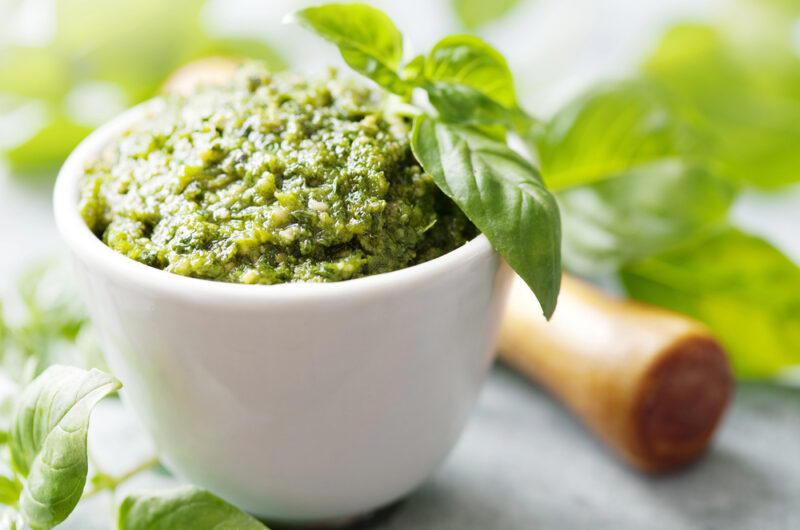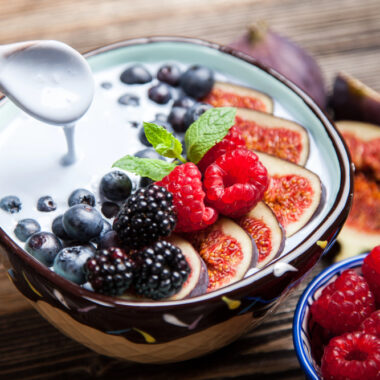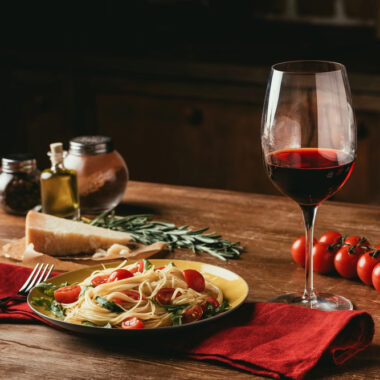Let’s talk about pesto. Is your favorite green pesto or red pesto, and what do you like to have it on? Pizza, caprese salad – what are your favorite ways to use it? I’m going to talk about the origins of pesto, and then about some of the ways you can use it, and how to make it. I often buy pesto from the grocery store, and sometimes I make it. Both ways can be delicious, and there’s so many different ways you can use it.
Pesto is traditionally Italian, and its roots are in ancient Rome. It’s best known today in the form pesto alla Genovese, which is made from basil, garlic, pine nuts, parmesan cheese, and olive oil. The concept of pesto can be traced back to ancient Roman times. Back then, there was a sauce called moretum, which was made by crushing herbs with garlic, some kind of cheese, salt, olive oil, and vinegar. In a similar way to modern pesto, it was prepared with a pestle and mortar. The word pesto comes from the Italian verb pestare, meaning “to pound” or “to crush” with the pestle and mortar.
The classic form of pesto, Genovese, comes from Genoa in Northwestern Italy. It’s from around the 19th century. The key ingredient, of course, is the Genovese basil that grows abundantly in that region. It loves the Mediterranean climate. The traditional recipe includes fresh basil leaves with garlic, traditionally pine nuts, Parmigiano Reggiano cheese, and lots of olive oil.
The traditional method of making pesto – using a pestle and mortar – is said to give us a much more flavorful, aromatic result than if we use a blender or a food processor. The idea is to gently crush the leaves. I find that when I’m using a pestle and mortar, I need to do the crushing of the dry ingredients first, before adding the olive oil, or they won’t get crushed properly. You crush the pine nuts with the basil leaves, and then you do the same with the cheese. Add the salt, and then when it’s all nicely crushed together, you can slowly add the olive oil in. We’ll talk about that more a bit later.
Pesto was very much a regional specialty until the 20th century. Later on, it started to spread across Italy, and then across Europe and internationally. Nowadays, you can find jars of pesto in pretty much every grocery store.
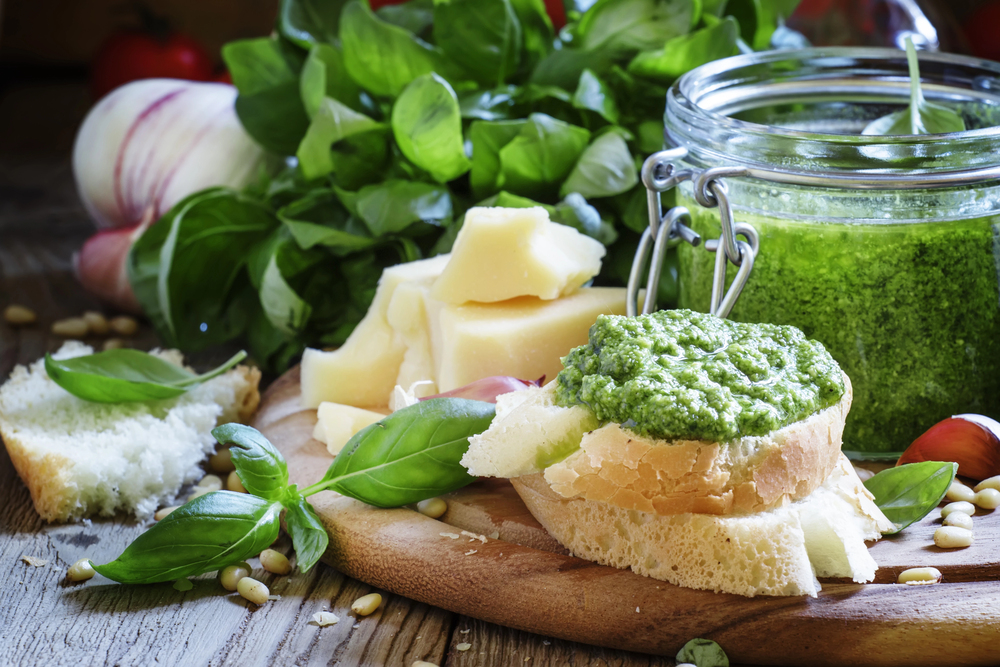
Genovese pesto – basil pesto – is the most well-known type of pesto. You also get some variations. Pesto Rosso comes from Sicily, and it’s made using sun dried tomatoes – a tomato pesto. You get pistachio pesto, made using pistachios instead of pine nuts. You can find arugula pesto, and even kale is sometimes used instead of the basil leaves. You can get a green pesto with a different variety of leaves. Of course, there are nut-free versions in which you don’t use nuts. Sometimes you can use cashew nuts to replace the pine nuts, or you can leave those out altogether, but then it’ll be a little bit thinner.
Pesto is traditionally served with pasta or with gnocchi, or even spread on bread. Let’s look at some more ways to use pesto – some things that are delicious when pesto is incorporated. The most traditional way that pesto is used, the most iconic, would be with pasta. You can have it in linguini or spaghetti. It’s amazing to just mix some basil pesto or basil pesto cream into that, and then just serve it – simple.
You can also have it on boiled potatoes or green beans, sometimes all tossed together. There’s lasagna al pesto, which has pasta sheets in layers, pesto, and bechamel or ricotta. There are no tomato sauces involved. That’s a lighter, aromatic style of lasagna. You can have pesto in soups, like in Minestrone alla Genovese, vegetable heavy minestrone soup. Just before serving, a generous spoonful of pesto is stirred into the soup. It’s not cooked with it, just folded in, so that that fresh basil flavor is preserved.
It’s also delicious to spread pesto on bread, like bruschetta or crostini. Those are toasted breads which can have a simple, delicious layer of pesto spread on top. You can add fresh tomatoes, fresh basil, and mozzarella. It’s good as an antipasto or appetizer. Pesto stuffed cheese, like burrata or mozzarella, is popular, although maybe not traditional. You can fill your cheese with pesto, or layer the pesto on top of it.
Pesto can be used along with cold meats; deli meats, and you can have it on picnics. You can even add it to a slice of baguette that’s not toasted. You can spread some basil pesto on it, and then put some mozzarella and tomato on top. Like I said earlier, pesto can be tossed with boiled potatoes or vegetables like green beans and zucchini. We like to steam slices of zucchini, toss it with basil pesto, and eat it with halmi. It’s a great appetizer. You can also have basil pesto in a frittata or as a topping for boiled or poached eggs.
Here are some less traditional and more unusual uses for pesto. You can use it as a pizza base. Instead of the tomato sauce, you can use pesto as the base of your pizza. You can use the basil version, or the sun dried tomato version. It’s also great on a normal pizza where you do use the tomato sauce, and you add basil pesto, basil leaves, and bits of mozzarella and tomato. Pesto also goes well with goat’s cheese, mozzarella, and mushrooms on a pizza. You can also put it with roasted vegetables. You can drizzle it over any cooked pizza to add a bit of flavor.
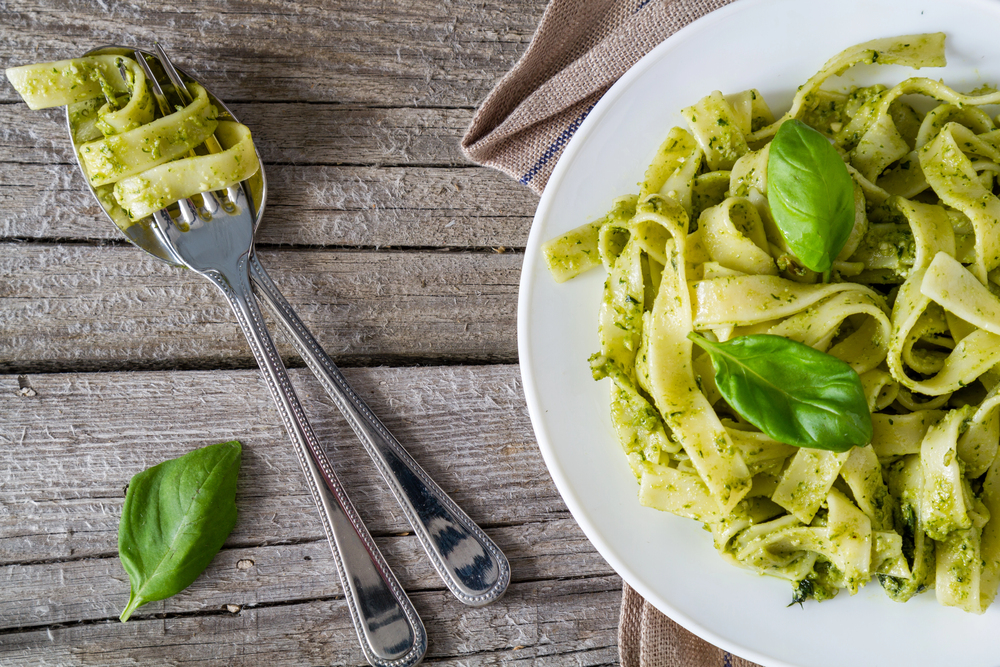
You can make pesto eggs. Add some pesto to a hot pan, and then scramble your eggs in that. You can fry the eggs in the oil, and the herbs infuse the eggs with flavor, and also make them taste a little bit less like egg, if that’s what you’re looking for. Pesto is great on toast, or as a sandwich spread. Use pesto instead of mayonnaise or mustard in a sandwich, a pita bread, or a panini. Pesto goes beautifully with chicken, turkey, mozzarella, roasted vegetables, or even prosciutto or ham.
Basil pesto makes a great salad dressing. You can thin it out a little with some lemon juice and olive oil, and then mix it with greens, a pasta salad, or even a roast vegetable bowl. Pesto is also great as a rub or a marinade for meat. It goes well with chicken, lamb, or fish. Rub it on before grilling. You can try it on salmon or cod, chicken thighs, chicken breasts, and even skewers of shrimp.
Pesto is great in stuffed pasta like ravioli or tortellini. You could also use it as a dipping sauce for stuffed pasta, or over the top of ravioli. Pesto butter is delicious. You can make it by blending pesto into softened butter and chilling it. Then you can spread it on your bread or corn on the cob. You can have pesto melted over roasted vegetables or meats like fish.
You can swirl it into savory goods, like savory muffins, scones, or quick breads. You can add it into your focaccia dough, or if you’re pastries out of puff pastry that you fill with cheese, you can mix basil pesto into those. You can make pesto pinwheels, where you spread the pesto over puff pastry, roll it up, slice it, and bake it for an easy appetizer.
You can use it in ramen with glass noodles or rice noodles. Stir a spoonful of it into your noodles, and it makes an amazing quick meal. That’s the amazing thing about pesto – you can mix it into noodles or pasta with a little bit of cream, and it’s immediately delicious. You can use pesto as a dip on your cheeseboard, alongside cheeses like ricotta, goat’s cheese, cheddar, and even burrata. Pesto is great on crackers. It’s amazing to have a dip of both sun dried tomato pesto and basil pesto with some sort of cream cheese or ricotta cheese to spread on your crackers. They compliment each other so well.
Lastly, let’s talk in detail about how to make your own pesto, and how to make it delicious. I’ll put the recipe at the bottom of this post. Gentle preparation is best; using a pestle and mortar, though you can use a food processor or even a blender if you’d like to. You need about two cups of basil leaves, as well as some fresh garlic, about two tablespoons of crushed pine nuts, about a quarter cup of Parmigiano Reggiano, a pinch or two of sea salt, and some extra virgin olive oil.
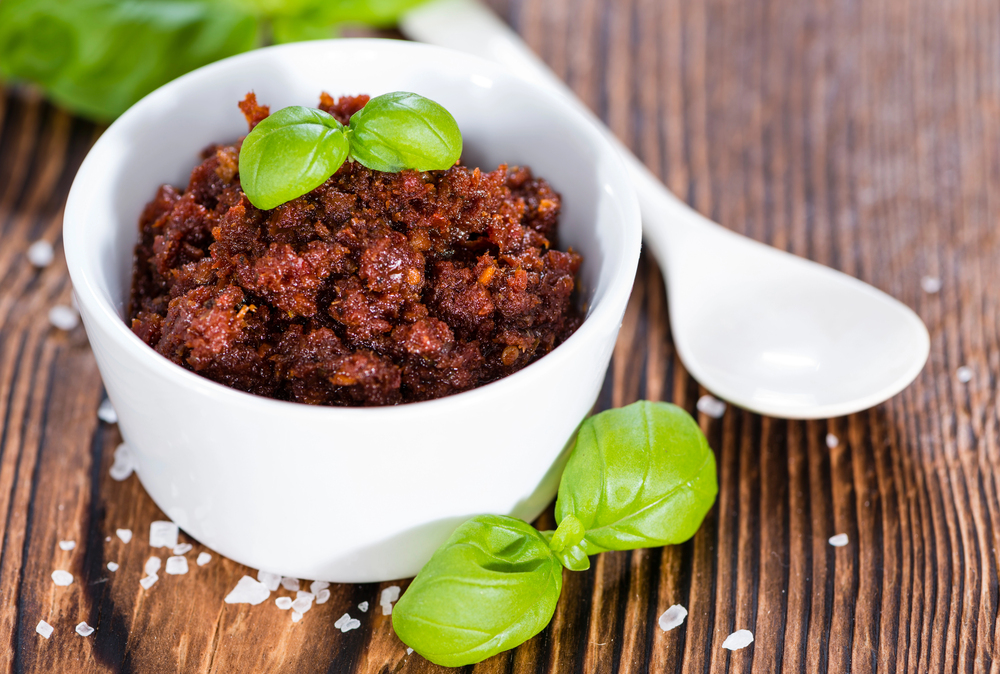
In your pestle and mortar, you should crush the garlic and salt together. Coarse salt is good for this. Gently crush it into a creamy paste using circular motions with the pestle. Then you can add the basil leaves gradually – a small handful at a time. Gently press them, rotating your pestle. It can make the pesto bitter if you tear them harshly, so it’s better to break them down slowly with the pestle. It takes time. They have to release their oils.
When the basil leaves are well broken down and the pesto’s looking creamy, you can add the pine nuts. Continue crushing it until it’s smooth, or until whatever consistency you like – it can have a bit of texture. Then you incorporate the cheese, the grated Parmiggiano Reggiano, and mix it in. You can also add some pecorino if you prefer a variety of flavors. Then you’re going to drizzle in the olive oil slowly, while mixing to emulsify it. You want the pesto to be thick, but it still needs to be pourable.
This will last in the fridge for a good week or so. You can also freeze it in ice cube trays and use a little bit whenever you like. Defrost it bit by bit. I like to add it to salad, or spread it on slices of cucumber.
If you’d like to make it in a food processor, then it’s faster, and still delicious. What helps is to freeze the blade for a little bit to prevent the oxidation of the pesto. You can add the garlic, pine nuts, and salt, and pulse that first. Then, when it’s finely minced, you can add in your basil leaves and pulse in short bursts until that’s finally chopped. Then add your grated cheeses and pulse again briefly. Then, with the motor running, you can use the smaller insert in the top, and slowly drizzle in the olive oil until the pesto’s smooth, but slightly coarse in texture. Taste it, and you can add salt if it’s needed. You can also add more cheese if you need to, Don’t overprocess it, or it will turn bitter. I don’t know about you, but I’m definitely craving some basil pesto right now!

